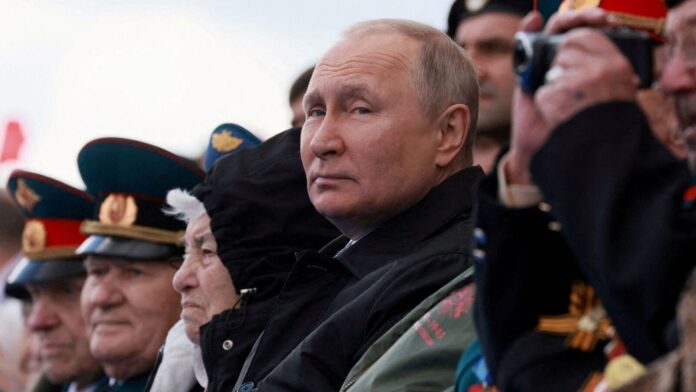IN BARRACKS SQUARE in old Helsinki stands an unusual monument to a war. A towering sculpture of a soldier’s winter snowsuit, its polished steel body is pierced with large round holes, as if still standing after a strafing by cannon fire. It is Finland’s national memorial to the winter war of 1939-40. During that conflict, Finnish troops withstood a huge Soviet force for 105 days, inflicting heavy casualties on the invaders before succumbing to the Red Army’s larger numbers. The Soviet Union imposed harsh terms, taking 10% of its neighbour’s territory. Peace proved fragile, and Finland was soon swept up into the second world war, fighting with Nazi Germany against the Soviet Red Army from 1941-44.
Unveiled in 2017, the memorial’s message is more timely than ever. The winter war has new resonance for Finns. Their country has known 80 years of peace. It boasts one of Europe’s most capable armies, backed by extensive military service for young men and large reserves. Yet even after ditching decades of neutrality to join NATO in April 2023, Finland remains haunted by Russia, its former imperial ruler and neighbour along a 1,340km shared border. “When Russia attacked Ukraine it was as if Finland’s wars were happening yesterday,” says a member of Finland’s tight-knit establishment. Indeed, this old hand worries about younger Finns being “too bold” in denouncing Russia. Membership of the European Union and NATO is all very well. But Finland is a small country whose fate has often been decided by great powers, and Russia will always be there. “We know that the big guys can always agree things above our head. We can always be alone.”
This is a moment for all Europe to ponder that memorial in a Helsinki square. For that battered, but still-recognisable uniform—hollow and headless, with the sky visible through its many holes—presents an important question. What can a country afford to lose, and what must it preserve, and still be true to itself?
When the cold war divided Europe, Finland made many sacrifices to survive as an independent nation. To preserve its capitalist system and parliamentary democracy, it became a neutral buffer state between the West and the Soviet Union. Until 1956 the Soviet navy was allowed to lease a base on the Finnish coast, within artillery range of Helsinki. KGB officers meddled shamelessly in Finland’s politics and society (though some Finnish officials and military officers quietly sent intelligence to the West, too). Bound by treaty to take Soviet security interests into account, the country’s compromised form of sovereignty was dubbed “Finlandisation” by critics. Finnish defenders of close relations with the USSR described their mission as “co-operating without losing one’s soul”.
Today, Finlandisation is back, this time as a model for Ukraine’s post-war relations with Russia. On a doomed peace mission to Moscow, days before Russia’s invasion in 2022, France’s President Emmanuel Macron called Finlandisation “one of the options on the table” for Ukraine. Mr Macron might not use the term now, for his line on Russian aggression has hardened greatly since then. But if the war ends soon, as America’s president-elect Donald Trump insists it must, leaders in Kyiv can expect pressure from many quarters to make painful compromises. A loss of some territory will surely be one price of peace. Then will come a hard question: how to secure Ukraine’s sovereignty in the future. Some Western governments may put their faith in deterrence of Russia, encouraging Ukraine to build a strong army and economy and to align its political system with European values. Other world leaders may push Ukraine to appease its neighbour by declaring itself neutral and accepting a place in Russia’s sphere of influence.
In Helsinki, foreign-policy thinkers have strong views on those seemingly opposite approaches to security, because cold-war Finland tried both at the same time. Finland maintained armed forces strong enough to make Soviet leaders recoil from the potential costs of trying to occupy the country formally. At the same time, it bought peace with many compromises, some of which look distinctly shabby in hindsight. In Helsinki today, the term Finlandisation is taken as a slur.
Realism but not fatalism
Circumstances imposed foreign-policy realism on Finland. The country’s survival could not be taken for granted in the late 1940s. It focused on preserving the essential elements of its sovereignty, without provoking the superpower next door. But this was realism with a purpose, rather than defeatism. Finland turned its agrarian economy into an industrial powerhouse and worked hard to expand its trade with Nordic neighbours and the wider world. The country signed a free-trade pact with Europe in the 1970s, despite growling opposition from Moscow. The post-war history of Finland saw “a step-by-step inching of our way towards the West”, says Hiski Haukkala, a former chief of staff to Finland’s president and incoming director of the Finnish Institute of International Affairs. “If a Ukraine peace is predicated on allowing Russia to dictate the terms, that would not be the Finnish lesson,” he adds. “That would be capitulation.”
A plaque next to the winter-war memorial offers a strikingly geopolitical take on those long-ago horrors. It blames the conflict on Hitler and Stalin’s secret agreement in 1939 to push Finland into “the sphere of influence of the Soviet Union”. The loss of over 25,000 Finnish lives is presented as an investment in a better tomorrow: a sacrifice to preserve Finland’s “independence, freedom and potential to develop into the Nordic welfare state that it is known as today”. Finland did not choose its geography. But—even in its darkest hour—it fought to choose its own fate. Literal Finlandisation would be a terrible model for Ukraine, turning it into a Russian satellite. But Finland’s sense of itself as a nation, and its will to survive, is an example worth studying.
© 2024, The Economist Newspaper Limited. All rights reserved. From The Economist, published under licence. The original content can be found on www.economist.com
#terrifying #perils #appeasing #warlike #Russia
